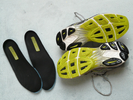
So What Are Insoles?
, by Ed Stone, 5 min reading time

, by Ed Stone, 5 min reading time
In poorly made shoes the insole typically offers very little actual support as these cheaper insoles tend to lack the type of structure needed to provide comfort and support. In contrast higher grade shoes feature insoles that are made of premium materials that hold their shape, offer greater cushioning, and are abrasion and sweat resistant.
A well made cushioned insole can do wonders to improve the overall life of the whole shoe, whereas a weaker insole can actually cause premature wearing. and can last the life of the shoe. Well constructed insoles help to extend the life of the shoe by keeping the foot centered so the shape of the shoe remains intact by keeping the foot centered within the shoe.
Before you look for the best insoles for work boots or best insoles for standing all day, let’s talk about the different types of insoles.
Insoles can be made out of all sorts of materials that are used in just about every shoe. Even with a huge variety of brands, shapes, styles, etc. insoles typically fall into one of the three major categories of insoles. Here is a quick synopsis about memory foam, orthotics, and plush insoles to give you some insight as to what differentiates these three main styles of custom insoles for any foot type.
Memory foam is the standard for most aftermarket support insoles as it tends to be a cost effective option for adding immediate comfort and standard support to the foot. Memory foam helps support the foot by contouring to the foot itself, inevitably causing a more even weight distribution within the shoe.
Not only does this even weight distribution help the shoe last longer by centering the weight within the sole of the shoe, it also helps to alleviate common problems like back pain, foot fatigue, joint issues, knee pain, and foot aches. The simple act of creating even weight displacement within the shoe helps keep the foot center, the body in alignment, avoid the development of any foot deformity, and an even wearing of the shoe for long lasting results.
Orthotics are the type of insole that is most commonly associated with extra arch support. While aftermarket insoles offer some kind of orthotic arch support, foot orthotics are designed to offer a greater amount of lift through the arch of the foot.
Typically, the rigid orthotic insole tends to be a little more rigid in an effort to ensure that the shoe insole doesn’t flatten out over time. This is not to say that foot orthotics are not as comfortable. In fact, many people with foot aches, knee pain, joint pain, and back issues find orthotics to be the most comfortable version of supportive insoles due to its proper positioning and cradling the foot.
Plush and fur lined comfort insoles are great for adding to a boot, running shoe, or footwear that is used in cold weather. Typically a plush insole also features a memory foam core that is simply wrapped in a warm, moisture wicking material like sheep's wool. Ideally a plush insole will be washable but not all of them are so it is important to check before you buy!
Plush insoles, while very effective at preventing your foot from becoming wet, have a tendency to get a little stinkier than their shoe insert or insole counterparts. Additionally, a plush cushioned insole is usually a little thicker than your average insole and can be a great way to make a loose fitting boot a bit more snug.
Here are some frequently asked questions about insoles and a few basic answers to help clear up any outstanding confusion:
Yes, every shoe comes with an insole that is glued to the inner of the shoe. However, not all insoles are created equal. For example, while high-quality men’s steel toe shoes or work boots might come standard with a moisture wicking, memory foam insole that helps alleviate pressure and foot pain, a standard flat or tennis shoe might only come with a basic flat or somewhat shapeless insole that ends up doing more harm than good. It’s always important to read the description of your shoes.
More often than not, a shoe with a great insole will make mention of it; and chances are if there’s no mention of the insole, it’s due to the fact that the insole probably leaves much to be desired.
This question, while more reliant on personal preference eventually becomes a “yes,” on a long enough timeline. Knowing how to clean shoe insoles might help make it last longer, even well made insoles eventually wear out, and usually the insole wears out faster than the rest of your shoe as it sees the most daily wear and friction. If you are interested in more comfort, greater support, or changing the fit of your shoe, you should look into getting a new insole.
Typically the type of shoe you wear, the activities you perform in that shoe, and the needs of your feet will dictate which type of insole you should purchase. While insoles are generally similar across the board, things like style, shape, and material plays an important role when choosing a new insole for your feet.
For all your insole questions and needs, check out Boot World’s premium selection of aftermarket insoles. Our wide variety of materials and styles ensure that you can find the perfect insole for your foot. Stop living with unnecessary foot and lower body pain and step into a new set of comfortable insoles today!